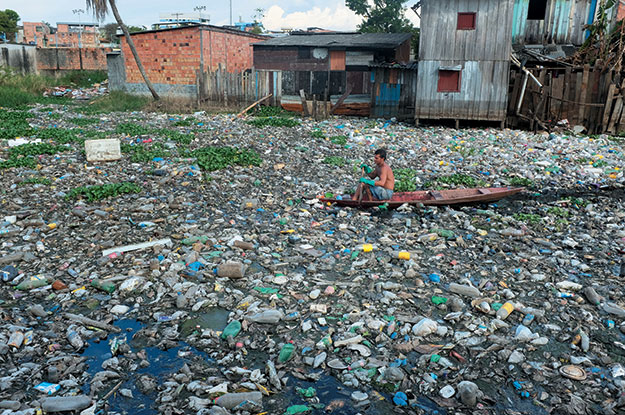Maria da Conceição Peixote has lived in a floating house on the Igarapé do Quarenta, one of the two longest waterways in Manaus, for most of her life. “I can’t afford to move,” says the 63-yearold housekeeper. “But it’s hard.”
Da Conceição and her husband, Natanel Baima de Oliveira, 60, a produce vendor, are among the hundreds of families who make their homes on the margins of Manaus’ polluted waters in tiny wooden houses perched on stilts called palafitas. Some 400 palafitas are located on the Igarapé alone — standing above the accumulating refuse. Things get really bad during the rainy season, between January and May, when the flooding of the Negro River and its tributaries turns the trash in Manaus’ waterways into unsightly dams.
The Municipality of Public Cleaning, an agency of the Manaus City Hall, says that an average of 30 tons of garbage is removed daily from the Amazon waterways — but that doesn’t seem to have made more than a dent in the problem. “Half of this waste is dumped by the residents themselves, unfortunately,” says da Conceição. “But the other part is thrown out by people from other neighborhoods — we see everything from plastic bottles to refrigerators to dead animals.”
It’s also the primary source of waterborne diseases that afflict residents, according to infectious disease specialist Antônio Magela of the Fundação de Medicina Tropical do Amazonas. The most common diseases, says Magela, are hepatitis A and E, acute diarrhea, intestinal parasites like amoebiasis and giardiasis, and also leptospirosis, an infectious bacterial disease.
Maria de Fátima Oliveira, 36, who shares a two-room palafita with her husband and their seven children, knows that all too well. “In the rainy season I’m always at the hospital with my sick children,” says de Fátima, who says she is saddened by the view from the balcony when she returns from work. “It’s not a pleasant sight.”
The landscape was very different during the lifetime of many of the residents. The Igarapés, a word that means “walkway of the water” in the Tupi-Guarani tongue, once served as recreational spots for city residents. But no longer. Today, Manaus’ rapid urban growth has obliterated many of the old waterways, and those remaining are heavily polluted. Only the waterways located in areas more distant from the Amazon capital are in a good state of conservation.
Jansen Zuanon, a scientist at the Instituto Nacional de Pesquisas da Amazônia, blames most of the pollution on the population, but he is quick to point out that the city’s poorest residents are not the only ones responsible for the accumulating refuse. According to Zuanon, the sewage is traceable not only to wealthier households, but to large enterprises, whose operations have destroyed nearby forest areas and springs. “With the loss of species, the ecological relationships and environmental services lent by the waterways also go away,” he explains.
In Zuanon’s opinion, the first step in cleaning up the mess is to stop dumping sewage. But that will require installing and modernizing sewage collection and treatment systems throughout the city of Manaus, and a well-planned ecological intervention. “Waterways that are environmentally intact carry clean water, help drain rainwater, reduce global warming, and maintain healthy biological communities, preserving biodiversity,” he says.
“Pollution of rivers is a reality in Manaus,” concedes Paulo Farias, municipal secretary of city cleaning. “Every month, we spend more than 900,000 reais (approximately $240,000) on this work. It is the most expensive cleaning method in the world, and has low efficiency, as waste reappears every day.”
The Amazonas government’s Social and Environmental Program for the Igarapés in Manaus (PROSAMIM) claims to have made progress in cleaning up waterways. But it has also been moving families from the palafitas themselves. According to PROSAMIM, 74,000 families have been resettled in new homes or compensated over the past 10 years.
Zuanon believes the actions of the municipal and state administration have been disastrous from an environmental point of view. PROSAMIM’s results are “negligible,” he claims, noting that the most that is done when channeling the waterways is containing ravines with sandbags mixed with cement. “The official strategy for dealing with polluted streams… only hides the mess and creates other problems,” he says.
—
Elaíze Farias is a Brazilian journalist from Amazonas state and cofounder of the Agência Amazônia Real.





